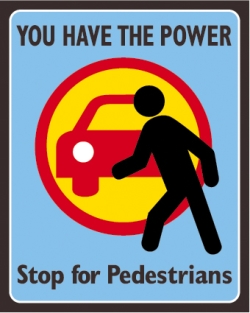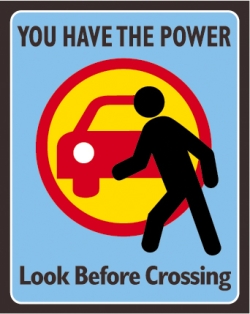Missoula Pedestrian Safety Campaign
Missoula, Montana
Source: Pedestrian and Bicycle Information Center (PBIC)
Problem
The city had a chronic problem of motorists not stopping for pedestrians in crosswalks. The crash data showed that on average there were around 35 pedestrian-motorist accidents each year, of which 80 percent were the driver's fault.
Background
The Missoula Bicycle and Pedestrian Program pursued a Congestion Mitigation and Air Quality (CMAQ) grant, funding the creation of a pedestrian safety campaign that began in 2004, and has been operating since.
Solution
The campaign educates the public through street signs, a media campaign, and police "stings." The program leaders recognized through the process that there were three key elements necessary to make the project have a lasting effect: 1) It must be multi-pronged, 2) It must be sustained over a long period of time, and 3) It must be relevant and appropriate to the local environment. Though the city was selected as one of three communities to pilot a pedestrian package developed by National Highway Traffic Safety Administration (NHTSA), the board determined that the dramatic message would cause a backlash of anger in the community, and they opted to develop their own program instead with the help of a local consultant.

One of the signs used in the Missoula campaign.
The signs bear the motto, "You Have the Power, Stop for Pedestrians," and are of nonstandard form and colors, in order to stand out to drivers. Almost 300 large and small posters were placed around town on signal poles and at in highly visible, yet unexpected, locations. The same logo and words were used in the radio and television spots to maintain a consistent message. Eighty percent of the messages were targeted at motorists and 20 percent towards pedestrians. Though over 2,700 radio spots were paid for, the department was able to air over 7,000 free spots. Any pedestrian facility improvements that are made are also announced to the press to garner additional attention to the subject of pedestrian safety. In addition, the board compiled a list of organizations maintaining membership newsletters, and sent out very short pedestrian safety messages every 6 months, requesting that they be included in the paper.
The Police Department also contributes to the efforts by conducting Pedestrian Safety Operations, or "stings," with great media coverage. Modeled after a program started in Redmond, Washington , one officer in plain clothes plays the role of a pedestrian, stepping off of the curb once the driver has reached a distance from the crosswalk which gives them plenty of time to stop. If the driver does not stop, the officers in motorcycles then pull them over to issues tickets. The typical fine was $140, and the board spoke with Judges asking them to not be lenient, in order to send the message that the law was serious.

Another sign used in the Missoula campaign.
The efforts are funded through a combination of local funds and a large CMAQ grant. Spread over the past 3 years, the total costs have come to roughly $90,000.
Result
Though the city lacks the resources to carry out any statistically valid evaluation, anecdotal evidence shows that locations notorious for drivers not stopping have seen a remarkable change. The same people who previously would report frequent "close calls" now say that drivers almost always stop for them.
Contact
Phil Smith
Bicycle Pedestrian Program Manager
Missoula Department of Transportation.
PSmith@ci.missoula.mt.us
(406) 552-6352.
Image Source
Phil Smitth, Missoula Department of Transportation.




